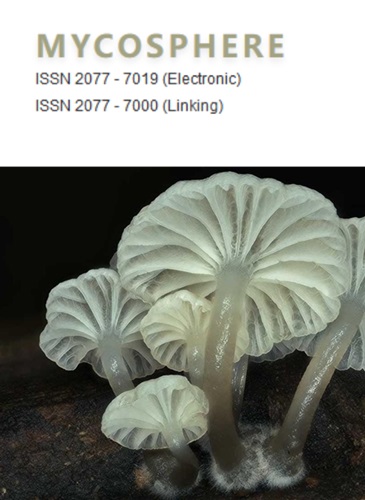Magnaporthiopsis species associated with patch diseases of turfgrasses in Australia
IF 15.1
1区 生物学
Q1 MYCOLOGY
引用次数: 2
Abstract
Isolates of Magnaporthiopsis (Magnaporthaceae, Magnaporthales) were obtained from turfgrass species with patch disease symptoms in sports fields and golf courses in eastern Australia. Patch disease was characterised by plants with root rot, vascular discolouration and dark, ectotrophic mycelium on the root surfaces. Four new species, Magnaporthiopsis dharug , M. gadigal , M. gumbaynggirr and M. yugambeh , are described based on phylogenetic analysis of concatenated partial DNA sequences of the internal transcribed spacer (ITS) region, RNA polymerase II largest subunit ( RPB1 ) and translation elongation factor 1-alpha ( TEF1α ). The descriptions of the fungi include morphological characteristics and host associations. Magnaporthiopsis dharug was isolated from diseased roots of Cynodon dactylon (couch grass, Bermudagrass), Festuca rubra ssp. commutata (Chewing’s fescue) and Poa annua (winter grass); M. gadigal from diseased roots of Pennisetum clandestinum (kikuyu grass); M. gumbaynggirr from diseased roots of C. dactylon ; and M. yugambeh from diseased roots of P. annua . µm wide, forming mycelial strands and curling back at the Conidiophores hyaline, single or branched. Conidiogenous cells hyaline, phialidic, straight or curved, 5–20 x 2–4 µm, narrowed at the base and tapering at the apex. Conidia hyaline, ovoid or cylindrical, mostly straight or slightly curved, 6–10 (–12) x 3–4 µm, apex rounded, base acute, aseptate, hyaline, smooth. Ascomata not observed in culture or on infected material.与澳大利亚草坪草斑块病相关的大孢子虫种
从澳大利亚东部运动场和高尔夫球场具有斑块病症状的草坪草种中分离得到了magnaporthopsis菌株(Magnaporthaceae, Magnaporthales)。斑块病的特征是根系腐烂,维管束变色,根表面菌丝体发黑。基于对其内部转录间隔区(ITS)、RNA聚合酶II最大亚基(RPB1)和翻译延伸因子1- α (TEF1α)的部分DNA序列的系统发育分析,描述了Magnaporthiopsis dharug、M. gadigal、M. gumbaynggirr和M. yugambeh 4个新种。真菌的描述包括形态特征和寄主关联。从阔叶草(Cynodon dactylon)、红羊茅(Festuca rubra ssp.)的病根中分离到一种药物。换向草(咀嚼羊茅)和冬草(冬草);锦尾草(Pennisetum clandestinum, kikuyu grass)的病根;青霉病根的M. gumbayngirr;黄花霉病根的黄花霉。µm宽,形成菌丝链并在分生孢子上卷曲,透明,单根或分枝。分生细胞透明,双亲状,直或弯,5-20 × 2-4µm,基部变窄,先端逐渐变细。分生孢子透明,卵球形或圆柱形,多数为直的或稍弯曲,6-10 (-12)× 3-4微米,先端圆形,基部锐尖,无裂,透明,光滑。在培养物或感染材料上未观察到Ascomata。
本文章由计算机程序翻译,如有差异,请以英文原文为准。
求助全文
约1分钟内获得全文
求助全文
来源期刊

Mycosphere
MYCOLOGY-
CiteScore
30.00
自引率
8.20%
发文量
9
审稿时长
4 weeks
期刊介绍:
Mycosphere stands as an international, peer-reviewed journal committed to the rapid dissemination of high-quality papers on fungal biology. Embracing an open-access approach, Mycosphere serves as a dedicated platform for the mycology community, ensuring swift publication of their valuable contributions. All submitted manuscripts undergo a thorough peer-review process before acceptance, with authors retaining copyright.
Key highlights of Mycosphere's publication include:
- Peer-reviewed manuscripts and monographs
- Open access, fostering accessibility and dissemination of knowledge
- Swift turnaround, facilitating timely sharing of research findings
- For information regarding open access charges, refer to the instructions for authors
- Special volumes, offering a platform for thematic collections and focused contributions.
Mycosphere is dedicated to promoting the accessibility and advancement of fungal biology through its inclusive and efficient publishing process.
 求助内容:
求助内容: 应助结果提醒方式:
应助结果提醒方式:


